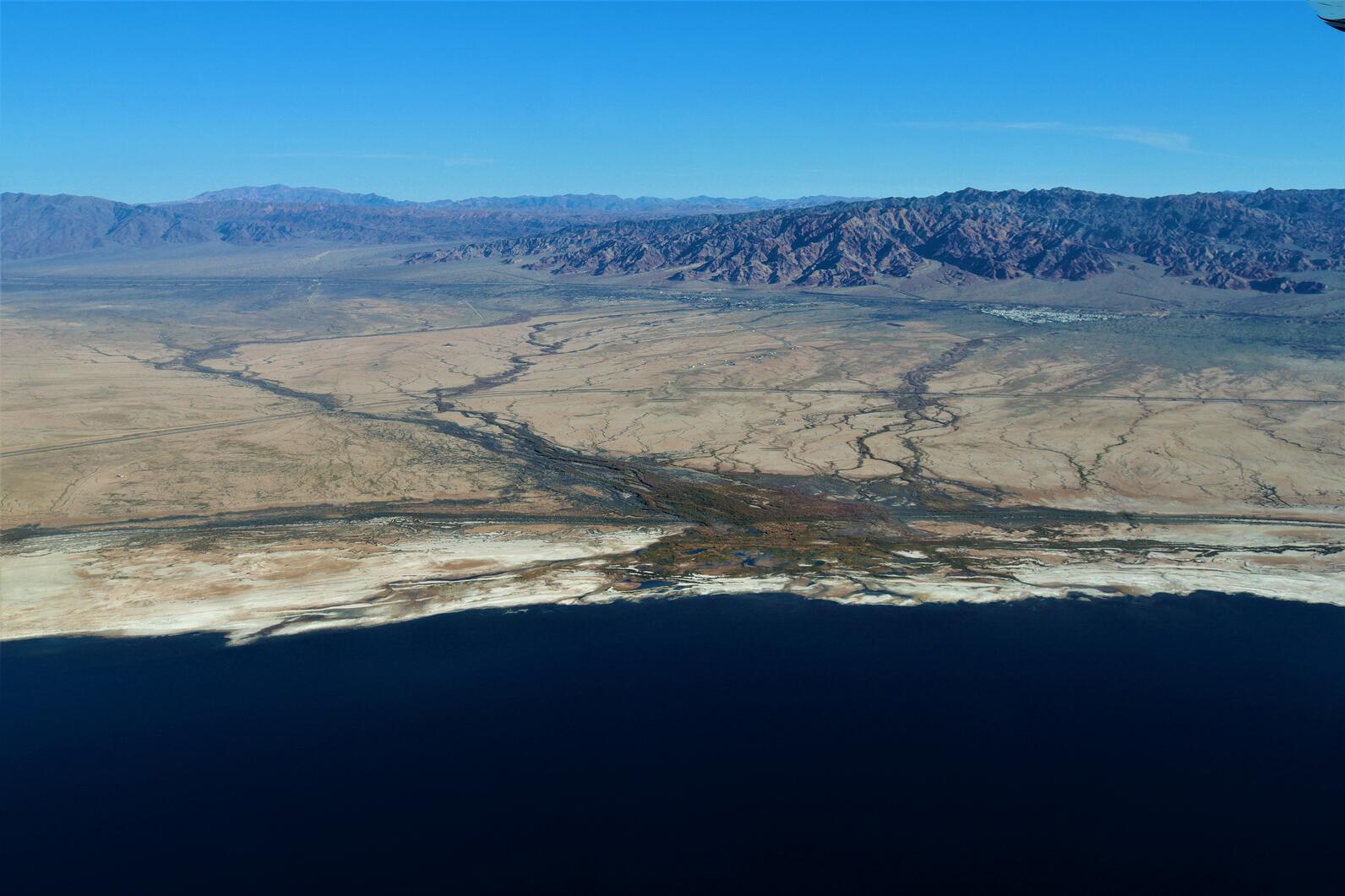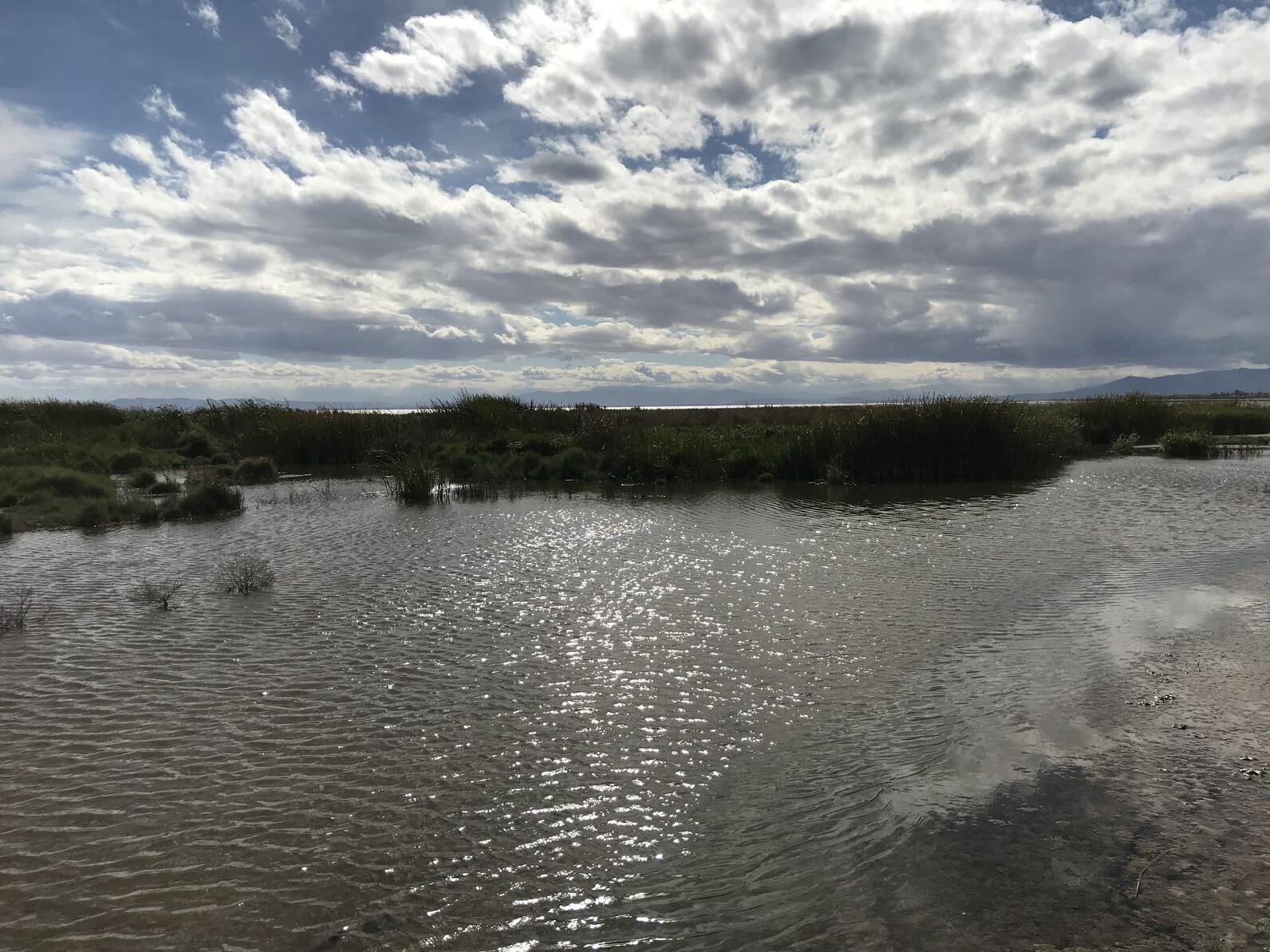Ridgway's Rail
Latin: Rallus obsoletus
Cómo un humedal emergente en la Laguna Salton Sea ofrece nuevas esperanzas para las aves migratorias y las comunidades locales.
Bombay Beach Wetland Project | Proyecto de humedales de Bombay Beach Photo: Emily Tozzi/Formation Environmental
La costa de la Laguna Salton Sea continúa retrocediendo rápidamente, dejando atrás la playa expuesta que exacerba las enfermedades respiratorias y otros problemas para las comunidades cercanas.
Inesperadamente, la recesión de la costa ha creado una oportunidad para que la naturaleza tome su curso, evidente por la presencia de humedales recién emergidos alrededor de la Laguna Salton Sea. Hay aproximadamente 6.000 acres de humedales recién formados que han surgido alrededor de la Laguna Salton Sea. Son producto de salidas agrícolas y filtraciones naturales de manantiales. En junio de 2020, Audubon California publicó un informe titulado "Identificación de áreas existentes para proyectos de protección/mejora del hábitat y supresión de polvo en la playa expuesta a la Laguna Salton Sea" que evalúa la cantidad y distribución de estos humedales.
Audubon California ha recibido una subvención de la Oficina de Recuperación de Tierras de los Estados Unidos que financiará el diseño del proyecto, las encuestas biológicas y la participación de la comunidad tanto para la supresión del polvo como para la expansión, estabilización, restauración y mejora de 250 acres de estos humedales emergentes cerca de la ciudad de Bombay Beach, en la Laguna Salton Sea. Estos humedales incidentales pueden servir para un doble propósito en la creación de hábitat vital para la migración de aves y la mitigación del polvo que pone en peligro la salud respiratoria de las 650.000 personas que viven cerca de la Laguna Salton Sea.
El humedal existente de Bombay Beach se encuentra en la costa sureste de la Laguna Salton Sea, a unos 3 millas al este de la comunidad de Bombay Beach. El área consiste en un humedal y vegetación circundante que se ha desarrollado donde convergen varios lavados prominentes y descargas de aguas subterráneas. Existen humedales salinos y hábitats de estanques salobres para especies como los rascón de ridgway (una especie en peligro de extinción), avoceta Americana, ánade rabudo, y para el pez cachorrito del desierto (una especie en peligro de extinción).
Sin embargo, el humedal existente seguirá siendo pequeño, sin restauración ni estabilización. Esto se debe a que el área de hábitat de mayor calidad en la cuesta arriba está siendo cada vez más dominada por un monocultivo de la planta invasora de tamariscos. Las especies de vida silvestre, sin embargo, ya están utilizando la zona, a pesar de la falta de restauración formal o gestión, lo que indica que hay una oportunidad para mejorar la zona.
La Laguna Salton Sea es importante para más de 300 especies de aves residentes y migratorias. Además, cuando no hay humedales o hábitats vegetados, hay playa que es responsable de la contaminación por polvo a las comunidades circundantes. Es imperativo que estos humedales emergentes en la Laguna Salton Sea se estabilicen para asegurar un hábitat suficiente a lo largo de la ruta migratoria del Pacífico y para mitigar la contaminación por polvo.

El Proyecto de Humedales de Bombay Beach tiene como objetivo estabilizar y mejorar varios humedales emergentes y salinos y hábitats de playa, proteger la salud humana mediante la optimización del uso del agua para promover la supresión de polvo en las playas cercanas, y proporcionar oportunidades recreativas para la comunidad.
La conservación y mejora de los humedales se hará protegiendo las áreas existentes de vegetación, humedales y hábitats acuáticos de las entradas de aguas pluviales perjudiciales con el refuerzo de las bermas costeras que protegen la zona.
El refuerzo de las bermas, complementado con infraestructuras de optimización del uso del agua, permitirá que el agua tenga un uso máximo beneficioso para el medio ambiente. Este proyecto tiene como objetivo optimizar el uso del agua para regar la vegetación en la playa adyacente al humedal para el control del polvo, mantener la salinidad en las zonas húmedas para una productividad óptima de las especies, y mejorar y promover nuevos hábitats en el humedal. También es posible incluir oportunidades de recreación comunitaria al aire libre, dependiendo de subvenciones futuras. De todas maneras, somos receptivos a la retroalimentación del público sobre posibles alternativas de diseño de proyectos e ideas de acceso público. Esperamos hacer de este humedal emergente un área que el público pueda visitar, las aves puedan vivir y un área que pueda ayudar a mitigar los problemas de salud pública.
Video aéreo del humedal Bombay Beach.
El Proyecto de Humedales de Bombay Beach se encuentra en la primera fase, que se espera que tome dos años, e incluye el diseño de proyectos de control de hábitat y polvo, monitoreo científico y recolección de datos, y la participación de la comunidad en el diseño de planificación. Tras la finalización exitosa de esta fase de planificación, la inauguración de la construcción comenzaría en 2023.

Estamos interesados en obtener comentarios y sugerencias públicas sobre el diseño de nuestro proyecto y las ideas de acceso público.Puede enviar un comentario público a través de nuestro formulario de encuesta aquí. Acompáñenos el 26 de abril para nuestra segunda reunión comunitaria [CB1] para aprender más sobre el Proyecto Humedal de Bombay Beach y compartir sus aportaciones con nosotros. El consultor para este proyecto es Formation Environmental, LLC, con otros grupos pendientes a medida que se desarrolla el progreso.
Vea nuestro documento sobre preguntas frecuentes, disponible tanto en español como en inglés, para obtener más información.
La financiación de este proyecto está siendo proporcionada por la Oficina de Recuperación de Tierras de los Estados Unidos. Este proyecto se está completando en cooperación con el Distrito Imperial de Riego (IID) y el Departamento de Pesca y Vida Silvestre de California (CDFW).
Estamos estrenando nuestra nueva, descargable guía de campo de algunas aves del Valle de Coachella, las cuales son culturalmente importante para los Cahuilla.
Poblaciones cambiantes -- además de algunos visitantes sorpresa
¡Niños pueden explora el mundo de las aves con actividades, artículos, videos, y más!
Communities around the Salton Sea are working together to protect human health and conserve critical bird habitats
Nearby communities, threatened wildlife have no time for further delays
Local television station KMIR today launched the first in a series of pieces about the Salton Sea. Today's piece is about the history of the Sea. Learn more about our efforts to find a solution at the Salton Sea here.
Clearly, the Desert Sun has had it with the state's inability to get projects moving at the Salton Sea:
This harkens to the years of “one more study is needed” that we’d wearily grown accustomed to as we witnessed the sea’s long decline, which shifted into overdrive with the end of Colorado River water inflows at the close of 2017.
Still, it is shocking to hear this type of refrain so shortly after the state finally stepped up with its plan to fulfill its commitment to sea restoration under the 2003 Quantification Settlement Agreement that has shifted the water that had been replenishing the sea to thirsty urban customers.
Get to work, folks. Promises were made and the state cannot let the now more-rapidly receding sea spiral into an ecological and environmental disaster which will have effects far beyond its own shores.
Audubon Calfornia's Frank Ruiz talks about the need for the everyone to pull together to avert an ecological crisis at the Salton Sea -- to protect people and birds at the Salton Sea. Thanks to the Walton Family Foundation for putting this video together. Learn more about our work at the Salton Sea.
The California Water Resources Control Board yesterday heard a presentation from state officials on their progress toward meeting their goals for habitat restoration and dust control at the Salton Sea. According to an agreement completed late last year, the state must complete work on 500 acres by the end of the year, but there is little indication that it will reach even that modest goal.
Micheal Lynes, Audubon California's policy director, had this to say after the hearing:
"The deterioration of the Salton Sea continues, and the rate of progress on the Salton Sea Management Program (SSMP) is not keeping up with the rapidly changing conditions. We encourage the State Water Resources Control board to work closely with state officials to ensure that upcoming deadlines are met– including constructing 500 acres’ worth of projects at the sea by the end of 2018.”
Michael Cohen, senior associate at the Pacific Institute, added:
"While the state has taken some steps towards implementing the Salton Sea Management Program, the rate of the progress is not nearly enough to keep up with the sea's decline. It is imperative that the State Water Resources Control Board hold the state to its commitment to build habitat and dust control projects at the Salton Sea, this year.”
Terrific op-ed in Water Deeply from Allison Harvey Turner Allison Harvey Turner, of the S.D. Bechtel Jr. Foundation, and Barry Gold, of the Walton Family Foundation, about the State of California's recent progress addressing the environmental and public health crises at the Salton Sea:
"At the Salton Sea, the state has the opportunity to demonstrate its commitment to supporting human health, a resilient environment, a strong economy and a sustainable water strategy for Southern California. Now, promising plans on paper must turn into critical progress on the ground. We are closer than ever to solving the Salton Sea crisis. This is the time for diligence and dedication to make it happen."
Earlier this month, Audubon California led a group of chapter leaders to offer a firsthand look at the situation at the Salton Sea. We also co-hosted a community event to raise awareness about the developing environmental and public health crises.
Our newsletter is fun way to get our latest stories and important conservation updates from across the state.
Help secure the future for birds at risk from climate change, habitat loss and other threats. Your support will power our science, education, advocacy and on-the-ground conservation efforts.
Join the thousands of Californians that support the proposed Chuckwalla National Monument.